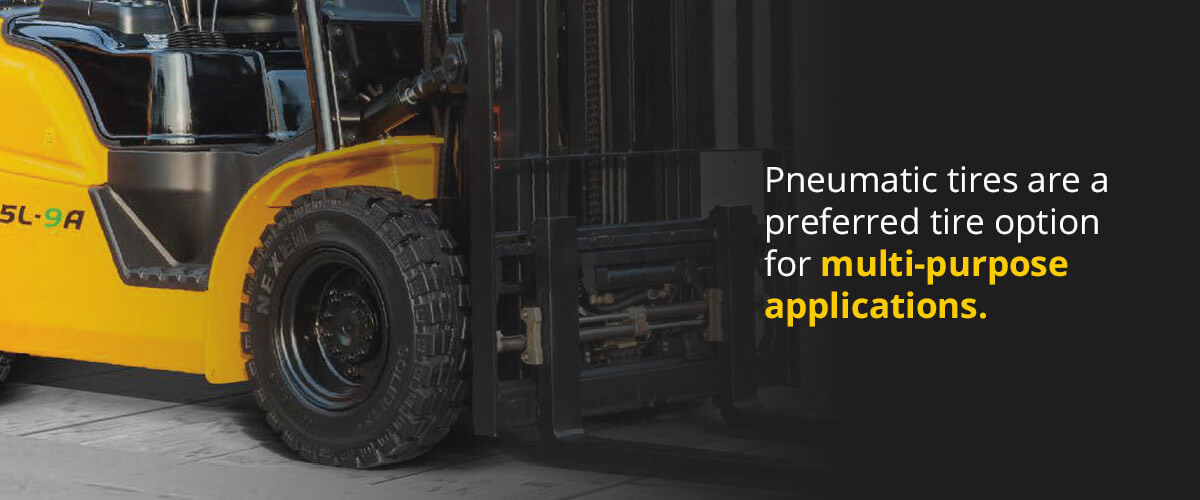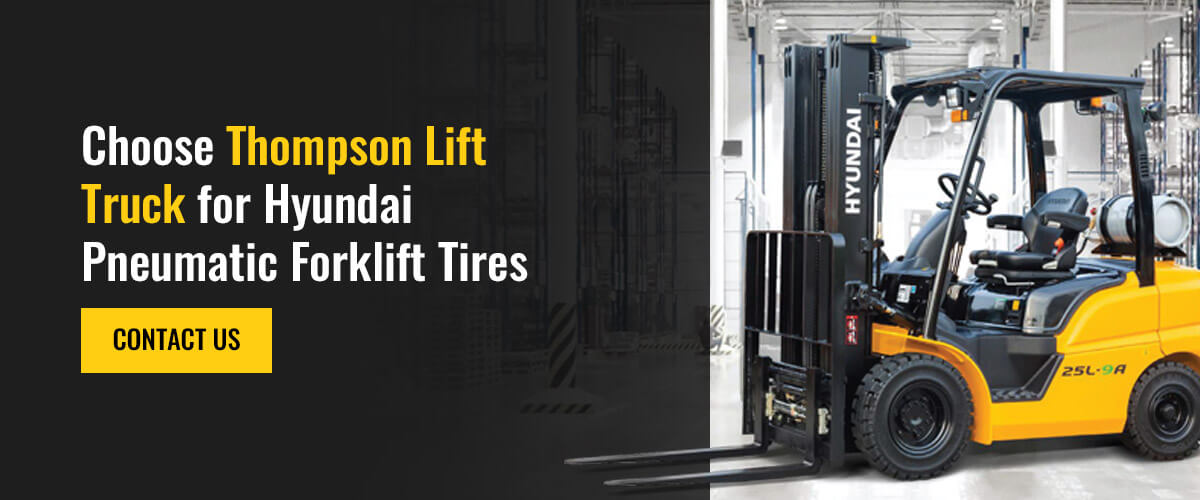
Guide to Hyundai Pneumatic Forklift Tires
If you’re in the market for new forklift tires, you may know there are several different tire options available. Purchasing new pneumatic tires for your Hyundai forklift is essential to keeping your lift truck running smoothly while maintaining productive business operations.
Read our guide to pneumatic forklift tires to learn all you need to know about how to maintain, change, and select the right pneumatic tires for your Hyundai forklift.
What Are the Different Types of Pneumatic Forklift Tires?
Forklifts can come equipped with different types of tires depending on the size, application, and type of forklift. In general, there are two types of pneumatic tires commonly found on forklifts:
- Solid pneumatic tires: Solid pneumatic tires are made from solid rubber. They’re used in either indoor or outdoor environments and are designed to provide a strong grip. Since they’re long-lasting and difficult to damage, they’re ideal in rugged conditions.
- Air-filled pneumatic tires: These air-powered forklift tires are pneumatic tires filled with air. The tire itself is made of hollow rubber, like the tires of a truck or car. Having a deeper tire tread than their solid counterparts, air tire forklifts are ideal for rugged and outdoor terrain.
Pneumatic Tires vs. Cushion Tires
Cushion tires, also known as rubber tires, are made from a solid rubber that’s fitted onto a metal band and pressed directly onto the forklift wheel. Compared to pneumatic tires, cushion tires:
- Sit lower to the ground
- Provide a tighter turning radius
- Operate best in indoor environments or smooth outdoor pavement
- Struggle on uneven surfaces, like gravel or dirt
Cushion tires are easier to manufacture and are more affordable because of the above characteristics. Because they’re meant for indoor or non-rugged work environments, cushion tires are also generally considered easier to maintain since they aren’t exposed to harsh outdoor conditions.
However, cushion tires have a few key drawbacks compared to pneumatic forklift tires. If your work requires you to operate a forklift outside of a smooth surface environment, like a warehouse or a loading bay, then cushion tires may not be the best solution for the job. Forklifts operated outdoors on more rugged surfaces, such as on construction sites or in lumber yards, face a number of factors that can put cushion tires at risk of damage.
Pneumatic tires are a preferred tire option for multi-purpose applications. Though the upfront investment is higher, they’re a longer-lasting, puncture-proof option that will keep your forklift operating at top performance no matter the conditions.
Can You Put Pneumatic Tires on a Cushion Tire Forklift?
Generally, you cannot, as tires and axles are specific to the forklift frame and lift capacity. However, some forklift manufacturers design models to be fitted with either cushion or pneumatic tires without having to modify the forklift frame.
Pneumatic Forklift Tire Maintenance
Pneumatic tires are an investment, so practicing good maintenance habits is important to extend their longevity. As with all tires, there are some basic maintenance steps to take regularly. There are also a few requirements specific to pneumatic tires, particularly when it comes to air pressure.
Below are some of the top tips on how to maintain pneumatic forklift tires:
- Check inflation pressure: For air-filled pneumatic forklift tires, it’s essential to routinely check the air pressure to make sure the tires are inflated to the correct level. Manufacturers print the required air pressure on the sidewall of the tire for operator reference. Keeping tires properly inflated prevents an odd or uneven wear pattern from developing.
- Inspect bearings and steering linkages: Sometimes, when an odd wear pattern develops on your forklift tires, it might not be a problem with the tire pressure but rather with other wheel and steering components. Be sure to inspect and replace bearings, kingpins, and steering linkages as necessary.
- Ensure enough torque on each wheel: Conduct routine inspections of your wheels to ensure they’re tight enough. Tighten wheels using a torque wrench and check that each wheel is torqued to the specified amount.
- Do a brake check: While you’re performing forklift tire maintenance, it’s a good idea to check your brakes, as well as other basic driving controls. Performing safety inspections at the same time as tire maintenance ensures you’ll catch any potential issues before they become costly problems.
- Know when to replace your tires: Most tire brands add a safety line, called the 60-J line, into the tire for operators to know when it’s time to replace the tire. When the tire wears out, the forklift driver ends up absorbing the majority of the shock when operating on a rough surface. Therefore, having good quality tires is important for ergonomics and safety. If you spot any damage, tearing, or cracking, it’s time to replace your tires.
How to Change Pneumatic Forklift Tires
When it’s time to replace or upgrade your forklift tires, you’ll need to know how to properly and safely change a pneumatic forklift tire. Below are the basic steps to follow when changing a pneumatic forklift tire:
- Lift the forklift: Jack up the forklift with a jack that’s rated for your forklift weight and secure it with blocks. Block the forklift at all four sides of contact.
- Remove the old tires: Use an impact gun to remove the lug nuts of the old tires. Remove the old tires from the forklift and dismount them from the rim. Depending on the model, this involves either removing the side and lock rings or splitting the top and bottom halves of the rims apart using a tire iron.
- Press the new tire onto the rim: How the new tire gets pressed onto the rim again depends on the rim type. You’ll either need to replace your lock and side rings or press the bottom half on first followed by the top half.
- Install the new tires: Once the new tires have been mounted on the rims, install them back onto the forklift. Torque them at the appropriate amount to ensure they’re tightly secured.
For air-filled pneumatic tires specifically, you’ll want to deflate the old tires before removing the entire wheel assembly from the forklift. Then inflate the new ones once the wheel assembly has been reinstalled.
Choose Thompson Lift Truck for Hyundai Pneumatic Forklift Tires
Invest in top-quality pneumatic forklift tires for your lift truck by choosing Thompson Lift Truck. We provide industrial lift truck solutions that support our customers through the entire equipment lifecycle. Choose us for your new forklift sales or used lift truck purchases, as well as ongoing equipment service and maintenance and parts replacements, including new Hyundai pneumatic forklift tires.
At Thompson Lift Truck, you’ll find a range of business solutions that help keep you operating at peak performance. Choose us for your rental equipment needs, as well as fleet management services and warehouse solutions from leading brands like Crown and Hyundai.
Contact us today to learn more about our full range of services and to get expert advice on purchasing new pneumatic tires for your industrial forklifts. Or visit one of our 22 locations throughout the Southeast, including Alabama, Georgia, Northwest Florida, and Tennessee.


